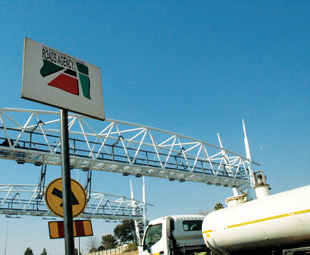New Freeway system takes its toll

Gautengers have increasingly been hearing about the benefits of the Gauteng Freeway Improvement Project (GFIP). That’s in the lead up to the launch of the new “user pays” open-road tolling (ORT) system on Gauteng’s freeways from April 2011 until 2013, which is how these freeway improvements and extensions are going to be funded. DAVID SHEPHERD found out it is not as simple as all that.
The toll roads in and around the three metros that comprise much of Gauteng are a complete con. Right or wrong? Before we get onto this rousing issue of toll roads, some clarity on the associated bureaucracy is required. South African National Road’s Agency Limited (Sanral) was established in 1998 with the passing of the Sanral Act. This Department of Transport agency is responsible for South Africa’s
16 150 km network of non-toll roads and toll roads. The current toll road network is funded via toll fees, and the cost of the non-toll network is borne by National Treasury grants to provincial transport departments.
Sanral’s GFIP is its current flagship project across Gauteng’s three metros. The first phase took off in July 2008 and will be complete towards the end of 2010. It consists of upgrading 185 km of existing freeway network by adding lanes to freeways such as the R21 and the N1, and improving interchanges to cut out bottlenecks. If you’ve driven on one of the upgraded four-lane freeways you won’t deny the positive effect they have had on traffic flow.
Few people take issue with the fact that improvements to the freeways are necessary. Improved highways coupled with better public transport – which has also been very much on government’s radar – do have the potential to make Gauteng’s economy run smoother, as Sanral points out. Sanral hopes to decrease congestion to the benefit of normal commuters and businesses by creating a linked network of inner and outer ring-roads. But while the second phase of the GFIP involves building new freeways from 2010 it also involves the hotly debated issue of paying for both parts of the project. And this will start when the ORT system comes on stream in April 2011.
Road users in Gauteng who haven’t already started seeing construction workers and construction equipment hard at work building a series of gantries over Gauteng’s freeway intersections for this ORT system, soon will. One such gantry near the
John Vorster off-ramp, in Centurion has already been completed and 41 other such gantries are being constructed.
The technology to implement the system has only been around for 15 years. Singapore, Canada, Chile and Australia have open-road urban toll systems. The gantries make possible a system of electronic toll collection that will allow drivers to travel through the toll without stopping. Detection devices on the gantries will pick up details from an e-tag which drivers will have on the windscreens of their vehicles. Payment can either be in the form of an automatic deduction from the user’s credit card or bank account, or motorists can buy credits like they do with prepaid cellphone airtime. Different vehicle classes will pay different tariffs, and frequent users may get discounts. At present it looks like motorists will be charged 65c/km and transporters, will be charged R3-50/km according to Alex van Niekerk, the Sanral project manager for the GFIP. Engineering News recently reported that, according to Van Niekerk, “the Minister of Transport has to approve the toll structure.”
But did the Sanral think the barrage of radio and print adverts about how the GFIP and the ORT system will improve our lives, would win everyone over? The new system has been a source of controversy for the last four years, and will continue being one. What chance do opponents of the system as it stands, have?
The technical aspects of the system have been better accepted than the financial implications. Presumably if all goes according to plan the companies commissioned to manage the system have done their homework. But the system is going to have serious implications for motorists and the transport industry, with the knock-on effects on the economy and consumers raising much controversy.
Many have pointed out that it is never as simple as “user pays” because costs get passed on to consumers in the price of products that have had to be transported by road. According to managing director of www.driving.co.za, Rob Handfield-Jones, “What Sanral has done with the GFIP is equivalent to the motor manufacturers saying ‘Rob, from next April, the only car on the market will be a Ferrari. We know you’ll love its features, styling, roadholding and power, so it’s worth paying the price for.’ And I will say: ‘Thank you, that’s marvellous, I can’t wait to drive my new Ferrari, but there’s just one problem – I don’t earn enough to buy a Ferrari.’ This is the problem Sanral is refusing to address – affordability.” Small transporters are going to be more harshly affected, likely forcing them out of business. “Many will go bankrupt. The larger ones will simply add the cost to their bill,” explains Handfield-Jones.
When the GFIP was first mooted it was Afriforum and the Democratic Alliance (DA) that opposed its roll-out in Gauteng. In August 2007 when national cabinet was signing off on the plans to toll Gauteng’s freeways, Afriforum said, “In the end, consumers will have to absorb the toll fees and we therefore can expect nationwide increases in food and building costs, to name but a few examples”. At the same time the DA opposed the tolling of existing roads in the Tshwane metropolitan area. DA transport spokesperson, Justus de Goede, said at that time, “The logical and fair way to finance toll roads is by ring-fencing the road tax contained in the petrol pricing structure and ensuring that it goes back into road expansion and maintenance. Rising private transport costs, and the lack of alternative public transport and tolls, place the consumer in an increasingly difficult position.” He has recently reiterated this stance.
The Road Freight Association (RFA) has also been strongly opposed to the new model of freeway maintenance and extension for the last four years. Gavin Kelly, RFA spokesperson and technical and operations manager says, “We are already contributing towards road maintenance by way of the fuel levy, licence fees and income tax. Where does this money go? It is definitely not used to the benefit of the road users from whom it is collected. Government continues to target motorists and truckers as an easy source of revenue for its road infrastructure development plans.”
With the tolling idea now prevalent in policy circles, Handfield-Jones argues they are about “extracting as much money as possible from existing taxpayers instead of broadening the tax base”. Sanral justifies the resort to private funding, or “user pays”, by saying it cannot always rely on the government as a source of finance, because unreliability jeopardises its ability to upgrade in an industry where on-the-spot repairs are necessary, as delays result in steep escalations in costs. The tolling issue epitomises the socio-economic conundrum faced by a country with the gap in wealth that South Africa has… tax the middle class wherever you can and pass on welfare benefits to the poor, without killing off the middle class in the process.
What factors will the authorities bear in mind when making the final decision about the fee structure? In this case many say it is a question of having gone too far in burdening the tax payer. The question is will Sanral experiment on consumers and motorists to find out? Gauteng motorists should know by October exactly how much they will have to pay per kilometre to travel on Gauteng’s improved freeway system.
In early May 2010 the RFA asked its members to register their objections to what it characterises as “the exorbitant toll fees being proposed by the Sanral”. The petition alerted those it was sent to of the Sanral’s plans to toll truckers at a rate of R3-50/km on its toll roads. With enough support behind campaigns like this opposing another major tax burden, in addition to increases in the electricity and the fuel price, and income tax hikes, you’d think maybe the middle class – and those who depend on them – stand a chance.
But, seeing as tolling is to be used despite vehement protest over the last few years, is there nonetheless a chance the RFA and their political allies can influence the rates that will be levied against freeway users – short of blockading the freeways? It’s definitely still worth asking whether the rates charged, if not the tolling idea itself, are partially revisable.
The sense in the RFA campaign opposing the “staggeringly high” toll fees for the freight industry surely lies in the fact that the method of funding road works that has traditionally been used – from the general fiscus and fuel levy – is still definitely available. It’s just that reverting to the traditional funding methods to avoid or dampen the worst effects of an exorbitant toll system will mean budgeting for the freeway system with money that government has, in the interim, probably decided it will use elsewhere.
Published by
Focus on Transport
focusmagsa



 Big news from FOCUS on Transport + Logist
Big news from FOCUS on Transport + Logist


 !
Starting 1 April, every
!
Starting 1 April, every


 FUSO: Driving the Future of Mobile Healthc
FUSO: Driving the Future of Mobile Healthc



 A brand
A brand




 Wondering about the maximum legal load for a
Wondering about the maximum legal load for a 
 The MAN hTGX powered by a hydrogen combus
The MAN hTGX powered by a hydrogen combus

 Exciting News for South African Operators
Exciting News for South African Operators


